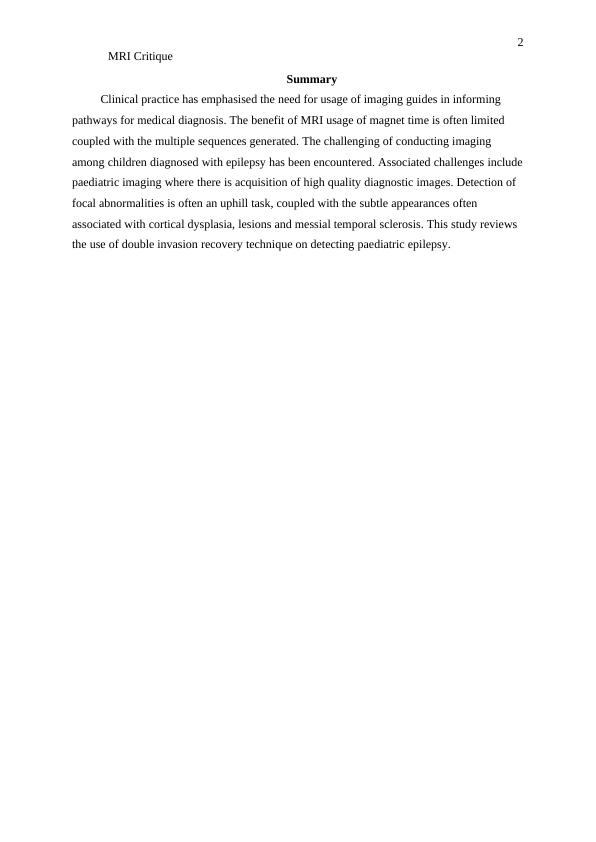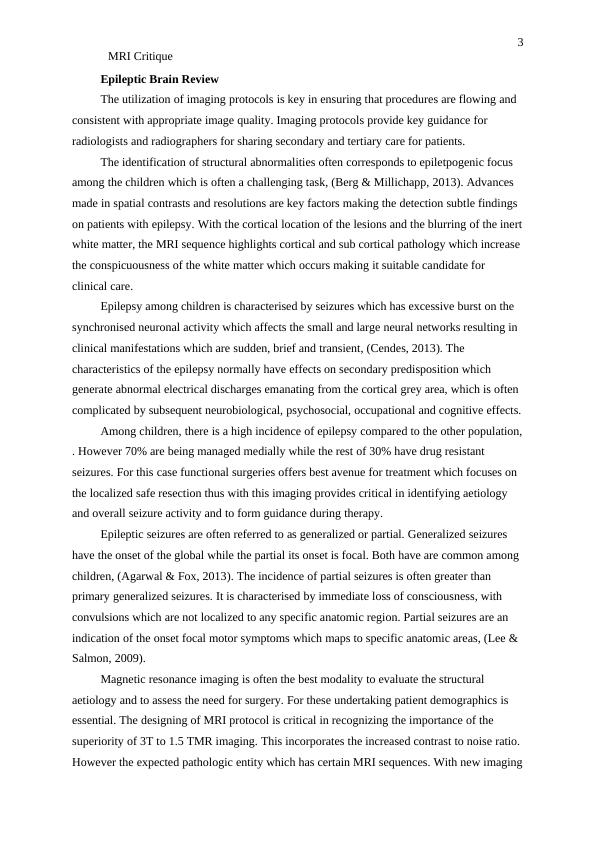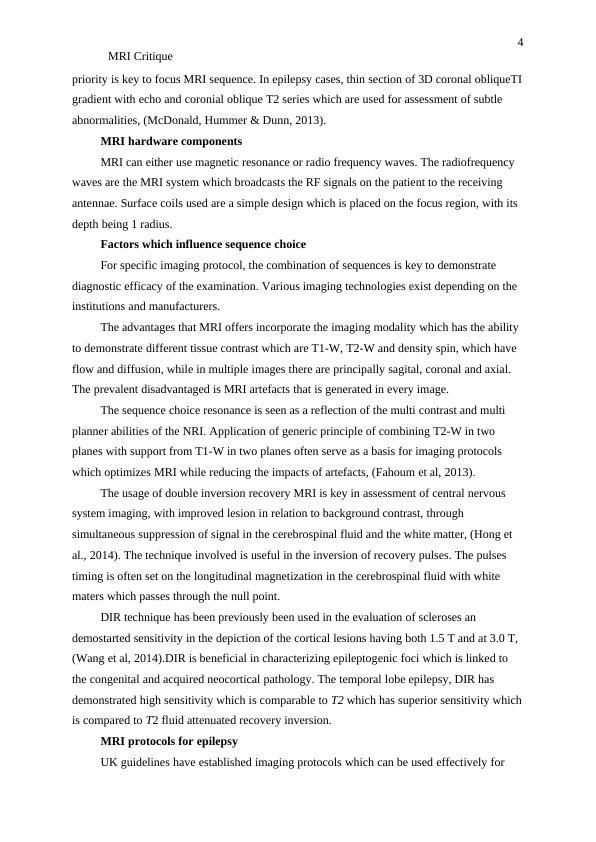Ask a question from expert
Assignment on Clinical practice
14 Pages3010 Words63 Views
Added on 2021-04-16
Assignment on Clinical practice
Added on 2021-04-16
BookmarkShareRelated Documents
Running Header; MRI ReviewUNIVERSITY:NAME :TitleDouble Inversion recovery for paediatric EpilepsyMRI Critique

2MRI CritiqueSummaryClinical practice has emphasised the need for usage of imaging guides in informing pathways for medical diagnosis. The benefit of MRI usage of magnet time is often limited coupled with the multiple sequences generated. The challenging of conducting imaging among children diagnosed with epilepsy has been encountered. Associated challenges includepaediatric imaging where there is acquisition of high quality diagnostic images. Detection of focal abnormalities is often an uphill task, coupled with the subtle appearances often associated with cortical dysplasia, lesions and messial temporal sclerosis. This study reviews the use of double invasion recovery technique on detecting paediatric epilepsy.

3MRI CritiqueEpileptic Brain Review The utilization of imaging protocols is key in ensuring that procedures are flowing and consistent with appropriate image quality. Imaging protocols provide key guidance for radiologists and radiographers for sharing secondary and tertiary care for patients.The identification of structural abnormalities often corresponds to epiletpogenic focus among the children which is often a challenging task, (Berg & Millichapp, 2013). Advances made in spatial contrasts and resolutions are key factors making the detection subtle findings on patients with epilepsy. With the cortical location of the lesions and the blurring of the inertwhite matter, the MRI sequence highlights cortical and sub cortical pathology which increase the conspicuousness of the white matter which occurs making it suitable candidate for clinical care. Epilepsy among children is characterised by seizures which has excessive burst on the synchronised neuronal activity which affects the small and large neural networks resulting in clinical manifestations which are sudden, brief and transient, (Cendes, 2013). The characteristics of the epilepsy normally have effects on secondary predisposition which generate abnormal electrical discharges emanating from the cortical grey area, which is often complicated by subsequent neurobiological, psychosocial, occupational and cognitive effects.Among children, there is a high incidence of epilepsy compared to the other population,. However 70% are being managed medially while the rest of 30% have drug resistant seizures. For this case functional surgeries offers best avenue for treatment which focuses on the localized safe resection thus with this imaging provides critical in identifying aetiology and overall seizure activity and to form guidance during therapy.Epileptic seizures are often referred to as generalized or partial. Generalized seizures have the onset of the global while the partial its onset is focal. Both have are common among children, (Agarwal & Fox, 2013). The incidence of partial seizures is often greater than primary generalized seizures. It is characterised by immediate loss of consciousness, with convulsions which are not localized to any specific anatomic region. Partial seizures are an indication of the onset focal motor symptoms which maps to specific anatomic areas, (Lee & Salmon, 2009).Magnetic resonance imaging is often the best modality to evaluate the structural aetiology and to assess the need for surgery. For these undertaking patient demographics is essential. The designing of MRI protocol is critical in recognizing the importance of the superiority of 3T to 1.5 TMR imaging. This incorporates the increased contrast to noise ratio. However the expected pathologic entity which has certain MRI sequences. With new imaging

4MRI Critiquepriority is key to focus MRI sequence. In epilepsy cases, thin section of 3D coronal obliqueTIgradient with echo and coronial oblique T2 series which are used for assessment of subtle abnormalities, (McDonald, Hummer & Dunn, 2013). MRI hardware components MRI can either use magnetic resonance or radio frequency waves. The radiofrequency waves are the MRI system which broadcasts the RF signals on the patient to the receiving antennae. Surface coils used are a simple design which is placed on the focus region, with its depth being 1 radius. Factors which influence sequence choiceFor specific imaging protocol, the combination of sequences is key to demonstrate diagnostic efficacy of the examination. Various imaging technologies exist depending on the institutions and manufacturers.The advantages that MRI offers incorporate the imaging modality which has the ability to demonstrate different tissue contrast which are T1-W, T2-W and density spin, which have flow and diffusion, while in multiple images there are principally sagital, coronal and axial. The prevalent disadvantaged is MRI artefacts that is generated in every image.The sequence choice resonance is seen as a reflection of the multi contrast and multi planner abilities of the NRI. Application of generic principle of combining T2-W in two planes with support from T1-W in two planes often serve as a basis for imaging protocols which optimizes MRI while reducing the impacts of artefacts, (Fahoum et al, 2013). The usage of double inversion recovery MRI is key in assessment of central nervous system imaging, with improved lesion in relation to background contrast, through simultaneous suppression of signal in the cerebrospinal fluid and the white matter, (Hong et al., 2014). The technique involved is useful in the inversion of recovery pulses. The pulses timing is often set on the longitudinal magnetization in the cerebrospinal fluid with white maters which passes through the null point.DIR technique has been previously been used in the evaluation of scleroses an demostarted sensitivity in the depiction of the cortical lesions having both 1.5 T and at 3.0 T, (Wang et al, 2014).DIR is beneficial in characterizing epileptogenic foci which is linked to the congenital and acquired neocortical pathology. The temporal lobe epilepsy, DIR has demonstrated high sensitivity which is comparable to T2 which has superior sensitivity whichis compared to T2 fluid attenuated recovery inversion. MRI protocols for epilepsyUK guidelines have established imaging protocols which can be used effectively for

End of preview
Want to access all the pages? Upload your documents or become a member.
Related Documents
Magnetic Resonance Imaging Protocol for Epilepsylg...
|10
|2752
|193